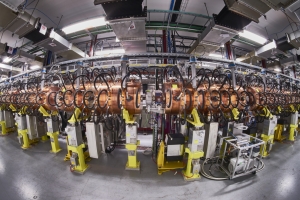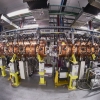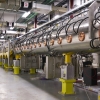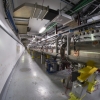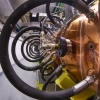CERN celebrates inauguration of Linac 4
2017.05.09 14:59 - udgov_hsCERN celebrated inauguration of the Linac 4 accelerator on May 9, 2017. The last of the machine four accelerating stages was manufactured in Świerk. Linac 4 will make possible to improve performance of LHC, the largest research facility on Earth.
Linac 4, a nearly 90 m-long new linear accelerator, produces and initially accelerates particles subsequently fed to further accelerators of which the entire Large Hadron Collider facility is composed. It will accelerate hydrogen ions up to 160 million electron-volts kinetic energy i.e. to an energy more than three times as high as the energy achievable by its predecessor, forty years old Linac 2. At the same time, density of particle bunches will be increased more than twice, which will help LHC detectors to acquire more data from the studied collisions.
Linac 4 is composed of as much as four accelerating stages that accelerate particles to higher and higher energies. The last stage composed of 12 accelerating Pi-Mode Accelerating Structures (PIMS) was manufactured by NCBJ in Świerk. While travelling that stage the particles gain energy from 102 MeV to 160 MeV. „Every of the 12 accelerating structures built by NCBJ is 54 cm in diameter and 150 cm long” – explained Professor Sławomir Wronka, Head of the NCBJ Particle Acceleration Physics & Technology Division. „Each structure houses 7 resonating cavities. 300 MHz microwaves propagating through the cavities accelerate bunches of charged particles traversing the cavities along their axes”.
Some highest-level competences were needed to accomplish the CERN order. „Our CNC machines have machined 26 tons of copper to high accuracy reaching 20 microns” – said Eng. Marek Marczenko, MSc, from NCBJ Nuclear Equipment Division. „Similar precision was needed at various other operations, including vacuum soldering of 12 input power resonators, each of a diameter exceeding 50 cm. Key operations were accomplished by operators wearing white latex gloves in order to exclude a possibility that any dirt deposited from hands might change electric parameters of the being produced work pieces and/or processed surfaces. Each of the manufactured structures was extensively tested (metrology, vacuum, ultrasounds, electromagnetic properties). It was very satisfying to learn in October 2016 (when the first Linac 4 run took place) that all elements produced by us were working well and perfectly cooperated with upstream structures of the Linac 4 machine”.
Buncher, one of the first LINAC 4 structures, is another contribution made by NCBJ scientists and engineers to the machine development. Buncher’s objective is to group particles into bunches, next accelerated in subsequent stages of the machine. „PIMS-es would not be possible without the earlier made buncher” – said Eng. Marczenko. „It was a great lesson how to manufacture large components with so high precision”.
Linac 4 is not going to start its regular operations before the long technical break in LHC operations, planned for 2019-2020. „Our capabilities to discover still new mysteries of our Universe depend on performance of the largest research facility on Earth” – said DSc. Krzysztof Kurek, NCBJ Director General, and a member of the LHCb experiment team. „Each of the machines in the particle accelerating chain is important for performance of the entire LHC, but the first stage is especially crucial. We are proud that we have managed to successfully produce some elements of that first stage. Our works on the LINAC 4 PIMS-es and buncher were highly appreciated by the world-class experts. Participation in development of such a large research facility gave us plenty of know-how and was an opportunity to build in NCBJ one of the few teams of experts on accelerating structures across the world. We are making a good use of competences of those experts not only to develop research facilities, but also to develop accelerators applied in medicine, industry and border security scanners”.
A ceremony held to inaugurate LINAC 4 was attended in Geneva by some NCBJ representatives with Director Krzysztof Kurek, along with representatives of several other research institutes and commercial companies from around the world involved in the development of that new accelerator.





